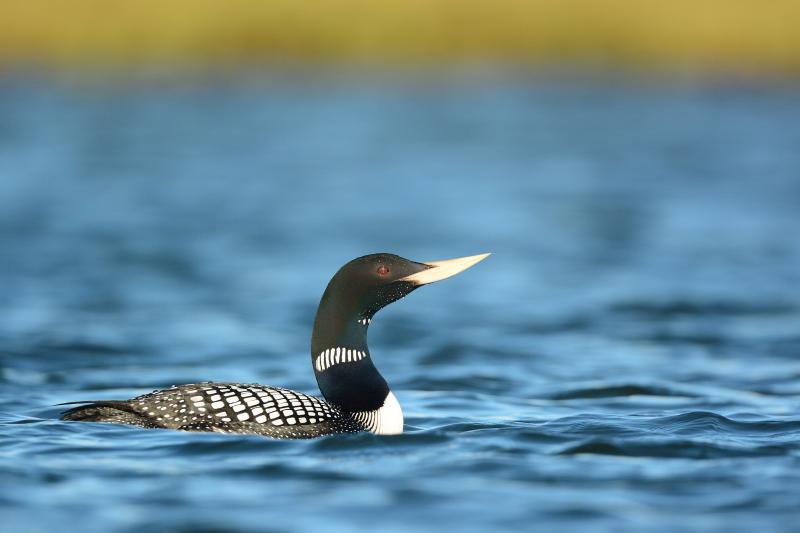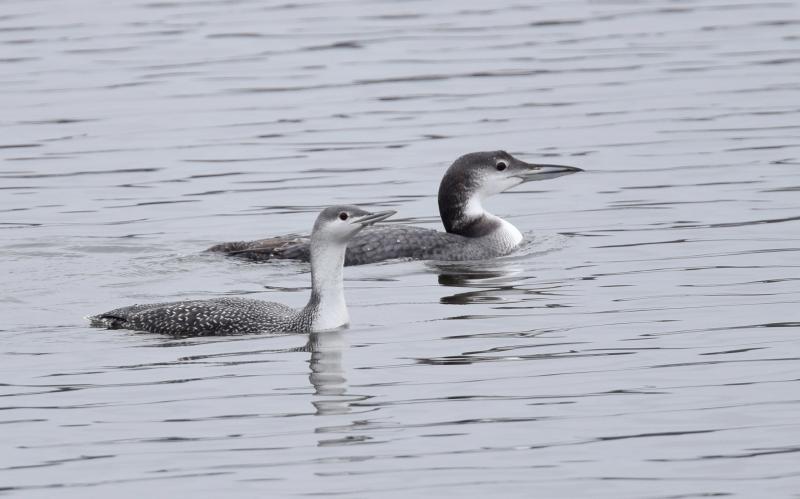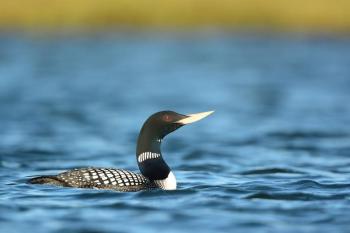How Many Kinds of Loons Have You Seen in Maine?
 The yellow-billed loon in breeding plumage is a stunner. Maine is lucky to have had one documented record of this species that normally occurs in winter along the coast from Alaska south to Washington State. Photo by Ryan Askren,
USGS, Alaska Science Center, courtesy of Wikimedia Commons
The yellow-billed loon in breeding plumage is a stunner. Maine is lucky to have had one documented record of this species that normally occurs in winter along the coast from Alaska south to Washington State. Photo by Ryan Askren,
USGS, Alaska Science Center, courtesy of Wikimedia Commons
 Red-throated loons are smaller and paler in their winter plumage than common loons, and they hold their bill tilted up. The bird on the left is a red-throated loon and the one on the right is a common loon. Photo by Andy Reago and Chrissy McClarren courtesy of Wikimedia Commons
Red-throated loons are smaller and paler in their winter plumage than common loons, and they hold their bill tilted up. The bird on the left is a red-throated loon and the one on the right is a common loon. Photo by Andy Reago and Chrissy McClarren courtesy of Wikimedia Commons
 The yellow-billed loon in breeding plumage is a stunner. Maine is lucky to have had one documented record of this species that normally occurs in winter along the coast from Alaska south to Washington State. Photo by Ryan Askren,
USGS, Alaska Science Center, courtesy of Wikimedia Commons
The yellow-billed loon in breeding plumage is a stunner. Maine is lucky to have had one documented record of this species that normally occurs in winter along the coast from Alaska south to Washington State. Photo by Ryan Askren,
USGS, Alaska Science Center, courtesy of Wikimedia Commons
 Red-throated loons are smaller and paler in their winter plumage than common loons, and they hold their bill tilted up. The bird on the left is a red-throated loon and the one on the right is a common loon. Photo by Andy Reago and Chrissy McClarren courtesy of Wikimedia Commons
Red-throated loons are smaller and paler in their winter plumage than common loons, and they hold their bill tilted up. The bird on the left is a red-throated loon and the one on the right is a common loon. Photo by Andy Reago and Chrissy McClarren courtesy of Wikimedia Commons
What bird is more iconic here in Maine than the common loon? In summer, there’s nothing more stirring than hearing the wailing cry of a loon echoing across the still waters of a Maine lake on a summer evening. Thousands of people eagerly keep track of the presence and success of the loons on their favorite lake.
Not everyone knows, though, that those birds of summer, with their lush black heads, black bills, and neat black-and-white checkered backs, are also one of our most regular birds of winter, just wearing a different costume. In winter, all along Maine’s coast, a more modest-looking version of the common loon can be seen just about anywhere, if you’re looking. The common loon in winter is a bird of muted gray and white, but it’s still has that same dagger-like bill and thick, blocky head.
The common loon is not the only loon that can be seen in Maine. Worldwide, the loon family has only five species. All of them have wide breeding ranges across the northern parts of North America and/or Eurasia, and they all spend winters in coastal waters or large, unfrozen lakes. The common loon extends the farthest south with rare occurrences as far south as southern Mexico and Cuba. In Eurasia, where it is usually called the great northern diver, individuals rarely make it as far south as northern Africa. None of the other four loons make it as far south—they are all birds of the northern half of the globe.
Surprisingly, four of the five loon species of the world have been documented here in Maine. The second-most likely-to-see species in winter here is the red-throated loon. It is the smallest of the five loon species. They are very pale in winter, with a snaky-looking slim head. They hold their slender bill pointing upward toward the sky. Common loons are darker with a shorter, stocky neck and a thick bill, which they tend to keep in a horizontal position.
Rare but seemingly increasingly regular here along the Maine coast in winter is the Pacific loon. The Pacific loon in winter plumage is smaller than the common loon, with a more rounded head, a shorter and slimmer bill (held horizontally) and often a line under the chin (a “chinstrap”). Pacific loons are primarily a species of western North America with the bulk of the breeding range extending from Alaska to Arctic Canada, and most birds wintering along the Pacific Coast from southeast Alaska to the Baja Peninsula of Mexico.
It used to be assumed that any Pacific loon that showed up along the East Coast (including in Maine) was an off-track bird. But Pacific loons actually nest in Quebec along the shores of Hudson and James Bays and the Ungava Peninsula. Pacific loons have been well-documented in migration and winter in recent decades all along the Atlantic Coast south to Florida and west to Texas. There seems to be one or more reported just about every year along the Maine coast. Could these birds in Maine and along the Atlantic Coast be from these Quebec breeding populations?
The fourth of the five loon species of the world that has been found in Maine is the stunning yellow-billed loon. In North America, this species breeds in the Arctic from Alaska to Nunavut and winters along the coast from Alaska to Washington state. Its large, yellow bill, held tipped toward the sky, is its most striking feature. Rather amazingly, one was found and photographed on a boat trip off Cape Elizabeth in October in 2010. How it might have found its way to Maine is anyone’s guess!
Jeffrey V. Wells, Ph.D., is a Fellow of the Cornell Lab of Ornithology and Vice President of Boreal Conservation for National Audubon. Dr. Wells is one of the nation's leading bird experts and conservation biologists. He is a coauthor of the seminal “Birds of Maine” book and author of the “Birder’s Conservation Handbook.” His grandfather, the late John Chase, was a columnist for the Boothbay Register for many years. Allison Childs Wells, formerly of the Cornell Lab of Ornithology, is a senior director at the Natural Resources Council of Maine, a nonprofit membership organization working statewide to protect the nature of Maine. Both are widely published natural history writers and are the authors of the popular books, “Maine’s Favorite Birds” (Tilbury House) and “Birds of Aruba, Bonaire, and Curaçao: A Site and Field Guide,” (Cornell University Press).

























